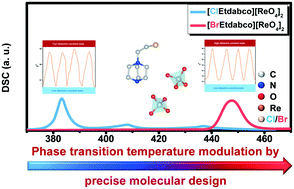High temperature molecular-based phase transition compounds with tunable and switchable dielectric properties†
Abstract
Molecular-based dielectric switching materials have recently attracted tremendous interest in the fields of data storage, signal processors and sensors due to their tunability, flexibility and good biocompatibility, which is promising for potential application in next generation wearable devices. Here, we successfully designed a series of organic–inorganic hybrid phase transition compounds and tuned the phase transition temperature by precise molecular modification. Specifically, we introduced different halide atoms (F, Cl and Br) into the quasi-spherical molecule and combined them with highly symmetrical rhenate, which induced the high temperature phase transition of [ClEt-Dabco][ReO4]2 and [BrEt-Dabco][ReO4]2 at 378 K and 425 K, respectively. The design and tuning strategy of high temperature phase transition materials in this work will not only enrich high temperature phase transition materials with switchable dielectricity but also promote the viable application of hybrid phase transition materials in the fields of sensors and flexible wearable devices.



 Please wait while we load your content...
Please wait while we load your content...